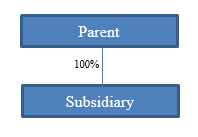
It’s the time of year when we all gather around with our families and loved ones. It’s also a good time to remember that your company may have its own family. Forgetting about that family can spell trouble.
The Internal Revenue Code (Code) and the Employee Retirement Income Security Act (ERISA) each include their own definitions of a controlled group, or a group of trades or businesses under common control. Generally speaking, companies are considered to be members of the same controlled group if there is at least 80% direct or indirect common ownership between or among different entities – the most common parent-subsidiary controlled group.
A simple example is a parent-subsidiary group in which the parent corporation owns 100% of its subsidiary or subsidiaries.

However, there are many more complicated rules that make this analysis less straightforward (just like family!). For example:
- There are brother-sister controlled groups – generally, a group of companies that have five or fewer owners who are individuals, trusts or estates that satisfy an 80% common ownership test and a 50% identical ownership test.
- There are complicated attribution rules which, when applied, may make members of a group that at first glance do not appear to be related to in fact be members of the same group.
- The option to purchase additional ownership rights is sometimes treated as actual ownership – for example, if Corporation A owns 70% of Corporation B (generally, not a controlled group), and has the option to purchase another 15% of Corporation B, then Corporation A could be treated as owning 85% of Corporation B, making them members of the same controlled group.
- ERISA applies different rules that can lead to different results, especially in the private equity fund and withdrawal liability contexts.
- The Code also includes complicated affiliated service group rules specifically designed to ensure that certain businesses in the service industry are considered to be members of the same group, even though they may not share any significant ownership.
So why does this matter? The determination as to whether or not two companies are members of the same group touches all areas of executive compensation and employee benefits, and can have a material impact on whether or not you are operating your benefit plans and executive compensation arrangements in accordance with applicable rules. For example:
- Controlled group status determines whether a plan is a single employer or multiple employer plan – a consideration that is especially important in the self-insured welfare plan context.
- Members of a controlled group are jointly and severally liable for certain obligations, including single employer pension liabilities, plan termination premiums, failure to notify the PBGC of reportable events, multiemployer termination and withdrawal liability.
- Nondiscrimination and coverage tests for qualified retirement plans and self-insured welfare plans must be run on a controlled group basis.
- Certain IRS limits, including the compensation limit under Code Section 401(a)(17) and Code Section 415, are applied on a controlled group basis.
- Service credit for eligibility and vesting in a qualified retirement plan must consider service with all controlled group members.
- COBRA obligations and penalties and the application of certain aspects of the Affordable Care Act depend on the number of employees on a controlled group basis.
- The controlled group rules apply to deferred compensation arrangements under Code Section 409A for purposes of certain rules, including the determination of when a separation from service occurs (but using a 50%, rather than an 80% standard), plan aggregation rules, and determining specified employees of publicly traded companies.
So, no matter the time of year, don’t let your company forget about its family!
